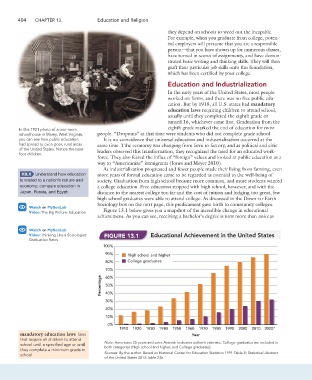Page 431 - Essencials of Sociology
P. 431
404 ChaPTEr 13 Education and religion
they depend on schools to weed out the incapable.
For example, when you graduate from college, poten-
tial employers will presume that you are a responsible
person—that you have shown up for numerous classes,
have turned in scores of assignments, and have demon-
strated basic writing and thinking skills. They will then
graft their particular job skills onto this foundation,
which has been certified by your college.
Education and Industrialization
In the early years of the United States, most people
worked on farms, and there was no free public edu-
cation. But by 1918, all U.S. states had mandatory
education laws requiring children to attend school,
usually until they completed the eighth grade or
turned 16, whichever came first. Graduation from the
eighth grade marked the end of education for most
In this 1921 photo of a one-room
schoolhouse in Marey, West Virginia, people. “Dropouts” at that time were students who did not complete grade school.
you can see how public education It is no coincidence that universal education and industrialization occurred at the
had spread to even poor, rural areas same time. Tthe economy was changing from farm to factory, and as political and civic
of the United States. Notice the bare- leaders observed this transformation, they recognized the need for an educated work-
foot children.
force. They also feared the influx of “foreign” values and looked at public education as a
way to “Americanize” immigrants (Jones and Meyer 2010).
As industrialization progressed and fewer people made their living from farming, even
13.1 Understand how education more years of formal education came to be regarded as essential to the well-being of
is related to a nation’s culture and society. Graduation from high school became more common, and more students wanted
economy; compare education in a college education. Free education stopped with high school, however, and with the
Japan, Russia, and Egypt. distance to the nearest college too far and the cost of tuition and lodging too great, few
high school graduates were able to attend college. As discussed in the Down-to-Earth
Sociology box on the next page, this predicament gave birth to community colleges.
Watch on MySocLab Figure 13.1 below gives you a snapshot of the incredible change in educational
Video: The Big Picture: Education
achievement. As you can see, receiving a bachelor’s degree is now more than twice as
Watch on MySocLab
Video: Thinking Like a Sociologist: Figure 13.1 Educational Achievement in the United States
Graduation Rates
100%
90% High school and higher
80% College graduates
70%
60%
Percentage 50%
40%
30%
20%
10%
0%
1910 1920 1930 1940 1950 1960 1970 1980 1990 2000 2010 2020*
mandatory education laws laws Year
that require all children to attend
school until a specified age or until Note: Americans 25 years and over. Asterisk indicates author’s estimate. College graduates are included in
they complete a minimum grade in both categories (High school and higher, and College graduates).
school Sources: By the author. Based on National Center for Education Statistics 1991:Table 8; Statistical Abstract
of the United States 2013:Table 236.

